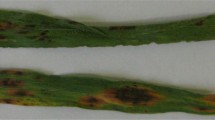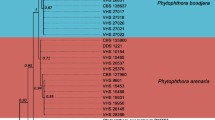Abstract
Phytophthora multivora, a recently described species recovered from declining natural ecosystems in Western Australia, was detected in the natural site of the rare and endangered Wollemi pine in New South Wales. The Phytophthora species was identified based on morphology and sequence analysis of the rDNA ITS and mitochondrial DNA cox1 regions. A pathogenicity trial to test the susceptibility of Wollemi pine to P. multivora resulted in symptoms equal in extent to those caused by P. cinnamomi, a known pathogen of Wollemi pine. Post-trial dry root weight analysis of P. multivora and P. cinnamomi inoculated plants revealed no significant difference between species, as both significantly reduced root mass compared to uninoculated plants. P. multivora was shown to be a pathogen of the Wollemi pine, and the implications on protecting this endangered species in the wild are discussed.



Similar content being viewed by others
References
Bullock S, Summerell BA, Gunn LV (2000) Pathogens of the Wollemi Pine, Wollemi nobilis. Australas Plant Pathol 29:211–214
Burgess TI (2013) Determining the origin of the emerging pathogen, Phytophthora multivora. 19th Australasian Plant Pathology Conference Proceedings 85
Burgess TI, Webster JL, Ciampini JA, White D, Hardy GESJ, Stukely MJC (2009) Re-evaluation of Phytophthora species isolated during 30 years of vegetation health surveys in Western Australia using molecular techniques. Plant Dis 93:215–223
Commonwealth Environmental Protection and Biodeiversity Conservation Act 1999, No. 91 (1999) [Online]. Available at: http://www.comlaw.gov.au/Details/C2014C00506
Daniel R, Guest D, Bishop T (2013) Management strategies for Phytophthora in the Gondwana Rainforests of Australia World Heritage Area. Australian Government and Caring for Country Project Report
Drummond AJ, Ashton B, Buxton S, Cheung M, Cooper A, Duran C, Field M, Heled J, Kearse M, Markowitz S, Moir R, Stones-Havas S, Sturrock S, Thierer T, Wilson A (2011) Geneious v5.4. Geneious v5.4
Dunstan WA, Rudman T, Shearer BL, Moore NA, Paap T, Calver MC, Dell B, Hardy GESJ (2010) Containment and spot eradication of a highly destructive invasive plant pathogen (Phytophthora cinnamomi) in natural ecosystems. Biol Invasions 12:913–925
Erwin DC, Ribeiro OK (1996) Phytophthora diseases worldwide. The American Phytopathological Society, St. Paul
Hansen EM, Reeser PW, Sutton W (2012) Phytophthora beyond agriculture. Annu Rev Phytopathol 50:359–378
Hee WY, Torrena PS, Blackman LM, Hardham AR (2013) Phytophthora cinnamomi in Australia. Phytophthora: a global perspective book series: CABI Plant Protection Series, p 124–134
Huelsenbeck JP (2001) MRBAYES: Bayesian inference of phylogenetic trees. Bioinformatics 17:754e755
Jones WG, Hill KD, Allen JM (1995) Wollemia nobilis, a new living Australian genus and species in the Araucariaceae. Telopea 6:173–176
Jung T, Stukely MJC, Hardy GESJ, White D, Paap T, Dunstan WA, Burgess TI (2011) Multiple new Phytophthora species from ITS Clade 6 associated with natural ecosystems in Australia: evolutionary and ecological implications. Persoonia 26:13–39
Liew ECY, Offord CA, Pinaria A, Pavich C, Summerell BA (2008) Effects of metalaxyl and phosphonate on Phytophthora root rot of Wollemi pine. 9th International Congress of Plant Pathology, ICPP 2088. J Plant Pathol 90(2, Supplement)
Martin FN, Tooley PW (2003) Phylogenetic relationships among Phytophthora species inferred from sequence analysis of mitochondrially encoded cytochrome oxidase I and II genes. Mycologia 95(2):269–284
New South Wales, Threatened Species Conservation Act 1995 No. 101 (1995) [Online]. Available at: http://www.austlii.edu.au/au/legis/nsw/num_act/tsca1995n101350.pdf
Newby Z (2014) Quantification of the risk of phytophthora dieback in the Greater Blue Mountains World Heritage Area. PhD Thesis. Faculty of Agriculture and Environment, The University of Sydney
NSW Department of Environment and Conservation (2006) Wollemi pine (Wollemia nobilis) recovery plan. NSW Department of Conservation, Hurstville
Peakall R, Ebert D, Scott LJ, Meagher PF, Offord CA (2003) Comparative genetic study confirms exceptionally low genetic variation in the ancient and endangered relictual conifer, Wollemia nobilis (Araucariaceae). Mol Ecol 12:2331–2343
Posada D (2008) jModelTest: phylogenetic model averaging. Mol Biol Evol 25:1253e1256
R Development Core Team (2010) R: a language and environment for statistical computing. R Foundation for Statistical Computing, Vienna, Austria. ISBN 3-900051-07-0, URL http://www.R-project.org
Rambaut A (2013) FigTree. http://tree.bio.ed.ac.uk/software/figtree/
Rea AJ, Burgess TI, Hardy GE, St J, Stukely MJC, Jung T (2011) Two novel and potentially endemic species of Phytophthora associated with episodic dieback of Kwongan vegetation in the south-west of Western Australia. Plant Pathol 60:1055–1068
Scott PM, Burgess TI, Barber PA, Shearer BL, Stukely MJC, Hardy GESJ, Jung T (2009) Phytophthora multivora sp. nov., a new species recovered from declining Eucalypts, Banksia, Agonis and other plant species in Western Australia. Persoonia 22:1–13
Scott PM, Jung T, Shearer BL, Barber PA, Calver M, Hardy GESJ (2012) Pathogenicity of Phytophthora multivora to Eucalyptus gomphocephala and Eucalyptus marginata. For Pathol 42:289–298
Stirling AM, Hayward AC, Pegg KG (1992) Evaluation of the biological control potential of bacteria isolated from a soil suppressive to Phytophthora cinnamomi. Australas Plant Pathol 21:133–142
Swofford DL (1993) PAUP - A Computer-Program for phylogenetic inference using Maximum Parsimony. J Gen Physiol 102:A9–A9
Thompson JD, Gibson TJ, Plewniak F, Jeanmougin F, Higgins DG (1997) The ClustalX windows interface: flexible strategies for multiple sequence alignment aided by quality analysis tools. Nucleic Acids Res 24:4876–4882
White TJ, Bruns T, Lee S, Taylor J (1990) Amplification and direct sequencing of fungal ribosomal RNA genes for phylogenetics. In: PCR protocols: a guide to methods and applications. Academic Press Inc. pp. 315-322
Acknowledgments
Funding for this project was provided by The Royal Botanic Gardens and Domain Trust. We thank all members of the Wollemi Pine Recovery Team, in particular Tony Auld, David Crust, Steve Clarke, Chris Pavich for field and sampling contributions. The first author would also like to thank The University of Sydney Faculty of Agriculture & Environment and The Royal Botanic Gardens Sydney for continued support. Zoe-Joy Newby, Ameera Yousiph, Lucas Shuttleworth, Liliana Rocha and Patricia Meagher are gratefully acknowledged and thanked for their advice and support throughout the study. We also thank Julie Bates for technical support and Emma Laurence for preparation of the figures.
Author information
Authors and Affiliations
Corresponding author
Rights and permissions
About this article
Cite this article
Puno, V.I., Laurence, M.H., Guest, D.I. et al. Detection of Phytophthora multivora in the Wollemi Pine site and pathogenicity to Wollemia nobilis . Australasian Plant Pathol. 44, 205–215 (2015). https://doi.org/10.1007/s13313-014-0344-1
Received:
Accepted:
Published:
Issue Date:
DOI: https://doi.org/10.1007/s13313-014-0344-1




